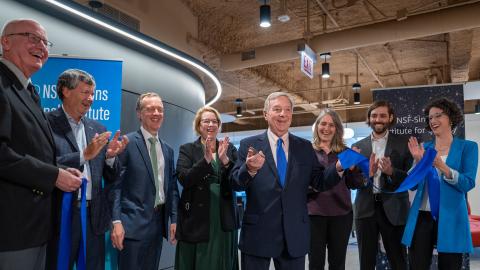Singing the national anthem before baseball games is such a time-honored practice that most fans barely give it a second thought.
But Joe Price, PhD'82, thinks a lot about the ritual's meaning — he says it provides "a doxology of sorts" for the national pastime. That's one reason why Price, a professor of religious studies at Whittier College who has sung the anthem dozens of times at pro ballparks, set out to sing it at 100 minor league games this summer.
Along with his wife Bonnie, Price will visit 40 states in five months, making stops nearly every night to perform "The Star-Spangled Banner." On the way, he's talking to fans about the song and the game, and documenting his journey in a blog. On July 27, Price will return to Illinois to sing for the Kane County Cougars in Geneva.
Price, an expert on the relationship between sport and religion, also plans to draw on the journey for his next book. Titled Perfect Pitch: The National Anthem For the National Pastime, the book will explore the ritual significance of the national anthem at baseball games.
The national anthem is "a hymn of consecration for the civil religion of baseball," Price says. "It brings together the civil sanction for the game. At the ballpark, fans stand with caps off, often with hands over hearts, facing the flag, either singing along or remaining silent and respectful during the anthem—much in the character of reverence that is accorded to identifiable religious rituals."
It's not all research — Price says he's a devoted baseball fan at heart. Yet he concedes his fascination with the pre-game anthem spawned "a weird hobby, to say the least."
Div School talks center around baseball
Price's interest in baseball and religion dates back to his time as a graduate student at the University of Chicago Divinity School, where he studied Christian theology.
One evening, Price and a fellow academic found themselves deep in conversation about baseball and its resemblance to religious ceremonies. The conversation stayed with Price; when he had the opportunity to develop a new course at Whittier, he and a colleague decided to examine sports from a religious studies perspective.
"There were very few texts that addressed the relationship between sport and religion at that time, so I concocted some points that the students could follow," Price remembers. Those early lectures eventually gave rise to two books — From Season to Season: Sport as American Religion and Rounding the Bases: Baseball as Religion in America.
His UChicago training helped shape his approach to the study of sports, Price says. "I had begun my PhD program in Religion and Literature, exploring ways that secular literature often engages spiritual matters and theological issues. So the hermeneutical methods that I began to study in that program prepared me to begin the analysis of the religious dimensions of sports."
Price's love of baseball goes back even further than his training in religious studies. The pursuit of perfection in baseball resonated with Price, the son of a preacher. "In the household I grew up in, perfection was an ideal that was unreachable, but somehow still the standard against which a life should be measured. Baseball is the only sport that identifies something as a ‘perfect game.’"
New York Yankee pitcher Don Larsen's legendary perfect game in the 1956 World Series made a lasting impact on Price. "I said, ‘Wow, you can have something perfect in sports.’ I became a passionate fan at that point."
Roadtrip a major undertaking
A colleague at Whittier first gave Price the idea for the anthem tour. He read a story about a fan who tried to see a game in every professional ballpark in one season. He suggested Price try to sing in every ballpark. "That planted the seed for the tour," Price says.
Minor-league parks held a special appeal. "The minor league parks really represent the diversity of the regions of America," Price explains. "They provide an intimacy and local color that is distinct from the corporate style of Major League Baseball."
After more than 300 hours of preparation and scheduling, Price and his wife Bonnie headed out in their RV. Most days follow a similar routine: Price drives all day, sings in the evening, talks with fans, and returns to the RV or a hotel to catch up on correspondence and transcribe his notes from the ballpark. The next day, he rises—by the dawn's early light, no less—to do it all again.
Price prides himself on his clear, understated rendition of "The Star-Spangled Banner." He sings at a brisk tempo, articulates clearly, and tries to keep the focus "on the words, rather than the performer." After all, he says, "It's not about the singer; it's about the anthem."
Although he sings night after night, Price says the experience of performing the anthem hasn't lost its magic. "Each ballpark is different. The acoustics are different. The fans' responses are different," he says. "In each instance, there's something fresh about it."









